Putting the Metal to the Pedals
Cities Commission Artistic Bike Racks to Give Streetscapes Local Flair
There’s something undignified about locking a bicycle to a rusty old rack—or worse, if there’s no bike rack at all, chaining it up to the nearest tree or street sign. Fortunately, cities and towns across the country are now transforming the traditional bike rack from an eyesore into a functional amenity that’s also literally a work of art.
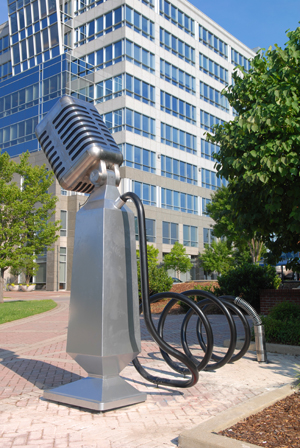
Metro Nashville Arts Commission
MUSIC CITY. Nashville, Tennessee’s nickname is clearly
reflected in this bike rack, complete with a microphone cord
that “plugs” into the ground.The City of Toledo, Ohio’s art bike rack program is in its third year. As of the spring, 30 racks designed by local artists were on the street in neighborhoods ranging from the emerging warehouse district to the hip Uptown.
“We try to select designs that are fun and whimsical and interesting in and of themselves. That’s part of Toledo,” said Nathan Mattimoe, art in public places coordinator with Toledo’s Arts Commission.
Although Mattimoe said some of the city-financed racks may not be as frequently used by cyclists as those in other locations, “We’re kind of OK with that. The racks are also sculpture that provide an aesthetic and infrastructure enhancement to the community.”
The Jersey Shore town of Belmar went with a beach theme for the few dozen racks it has installed along its Main Street commercial and residential district. The racks are designed to look like surfboards or ocean waves.
“Our racks have been very well received, particularly by the business owners located along Main Street,” said Mayor Matt Doherty. “They are heavily used by cyclists and they help bring some artistic flair to what would otherwise be a very dull bike rack.”
Nashville, Tennessee, will have 17 city-funded bike racks installed in parks, greenways, and retail centers by the end of this year. The racks—some of them sculptures reaching 12 feet tall—are all designed by local artists.
“We’ve worked really hard with our cycling community to promote these bike racks,” said Caroline Vincent, public arts manager with the Metro Nashville Arts Commission. “And we’ve also created some bike tours of public art so people can see our bike racks and we can further promote their usage that way.”
Philadelphia’s art bike rack program is just ramping up following an initial design competition. Margot Berg, public art director with the city’s Office of Arts, Culture, and the Creative Economy, said the first of nine racks will be installed in temporary “pop-up gardens” or vacant lots after being displayed in galleries this summer. After that, the racks—paid for by a combination of grant funding and money from developers or property owners interested in having them at their locations—will find permanent homes in Center City. “There is a significant bike commuting and bike delivery/messenger population,” said Berg, adding, “We got a lot of designs from cyclists.”
Portland, Oregon, a city known for its progressive and thriving bike culture, now has between 100 and 200 uniquely designed racks installed through its privately funded Art Rack program that’s been operating for about 10 years.
“These racks are different,” conceded Timo Forsberg of the Portland Bureau of Transportation’s Active Transportation Division. “They’re not going to freak anybody out, but they add a little whimsy to the streetscaping to make it more fun. … The more things there are for people to notice and enjoy in the streetscape make it a more pleasant place to be.”
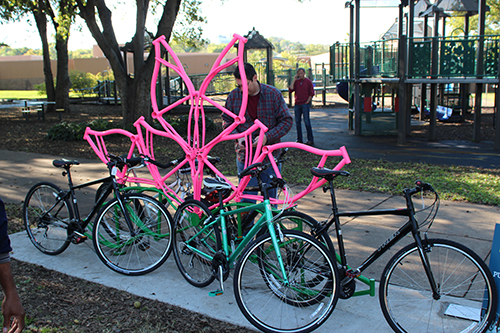
Metro Nashville Arts Commission
A RACK WITH REPURPOSE. Constructed from old bike frames, this Nashville rack depicts a lotus figure that
can accommodate several bikes.
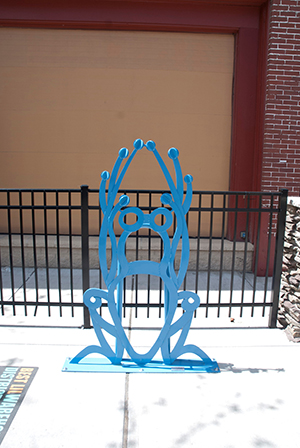
The Arts Commission/City of Toledo
FROGGY FUN. Toledo, Ohio calls itself the Frog City, which
helps explain this bike rack. “When you’re walking around and
you come across these pieces, they provide a moment of
interest and hopefully a fun experience…and regardless of
whether they’re actually used as bike racks, they become
landmarks.” said Toledo’s Art in Public Places Coordinator
Nathan Mattimoe.
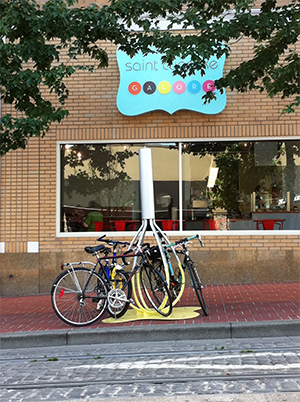
Portland Bureau of Transportation Archive
BAKER’S RACK. Cyclists with particularly good taste get to lock
their bikes to this creative rack outside a Portland, Ore., bakery.
Note the spilled “batter” on the ground under the whisk.
Portland’s racks are privately funded, “usually by a business
that wants to have an interesting streetscape feature,” said
Timo Forsberg of Portland’s Bureau of Transportation.
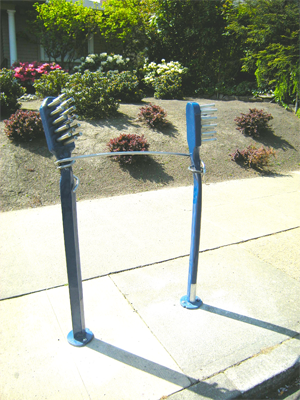
Portland Bureau of Transportation Archive
DON’T FORGET TO FLOSS! This unusual bike rack depicting
toothbrushes and even dental floss was financed by a Portland
dental practice. “There are some designs that are so interesting
looking you almost never see a bike parked there,”
acknowledged Forsberg.
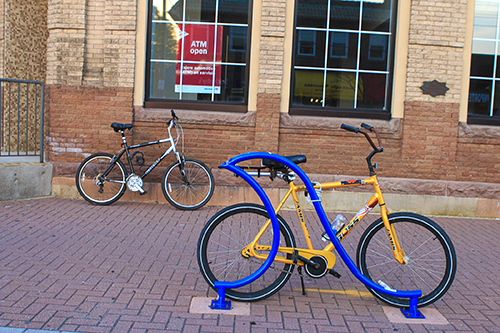
Stephen Lacko/Borough of Belmar
DUDE, THAT’S MY WAVE. This bike rack outside a Belmar bank a few blocks from its popular Jersey Shore
beach and boardwalk depicts a rolling ocean wave. “These racks are part of the character of the town,”
Belmar mayor Matt Doherty said.
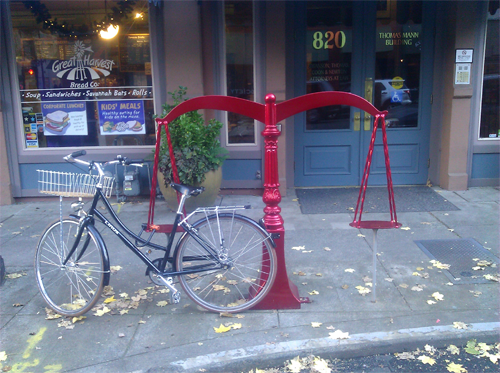
Portland Bureau of Transportation Archive
BALANCING FORM AND FUNCTION. A law firm cleverly uses a Scale of Justice theme for this rack installed
outside its Portland, Ore., offices.
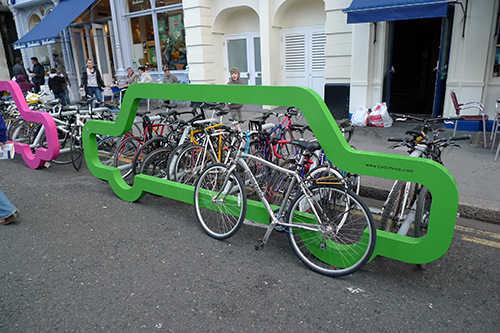
PARKING SPACE. This rack by London-based Cyclehoop was designed to illustrate how many bikes can
fit in the space of one parked car.
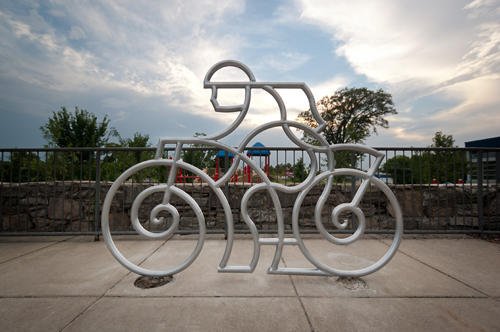
Metro Nashville Arts Commission
LYRICAL RIDER. This striking Nashville, Tenn., bike rack almost looks too nice to use. “There’s that
question … this is a bike rack? Can I put my bike on it? So, we’ve tried to be a little more careful with
signage,” said Caroline Vincent.
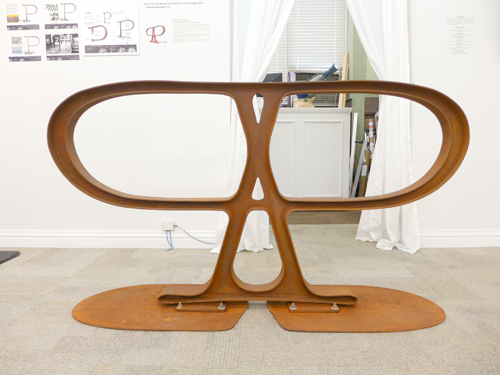
GOOD ENOUGH TO EAT? Some Philadelphia bike racks are designed to look like the pretzels the city
is famous for. They’ll be permanently installed later this year in “locations without a lot of constraints and
with need, opportunity … and donors,” said Margot Berg, the city’s public art director.